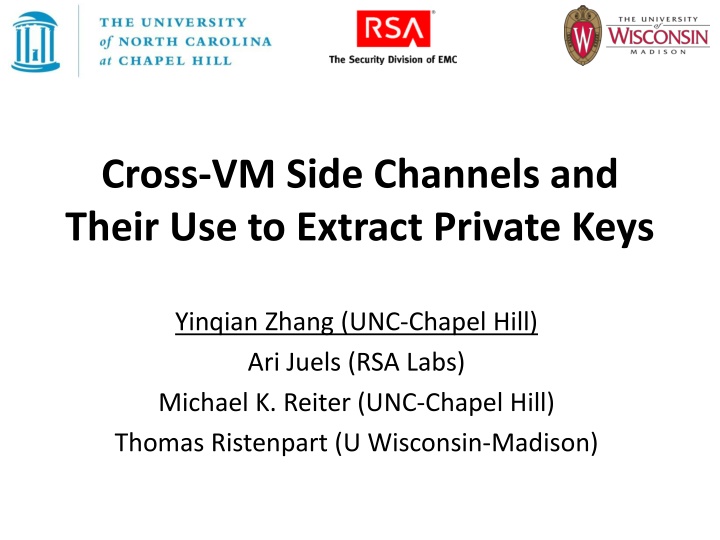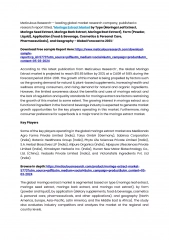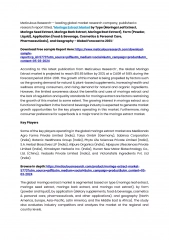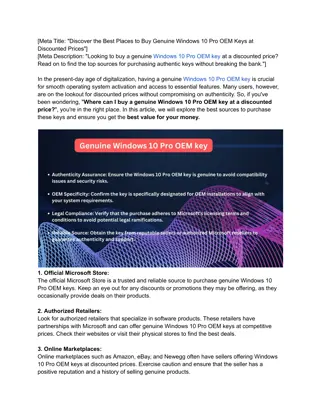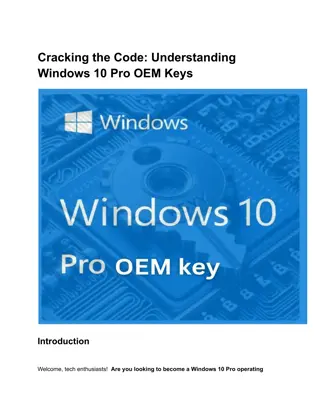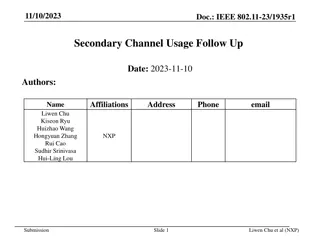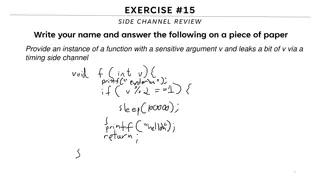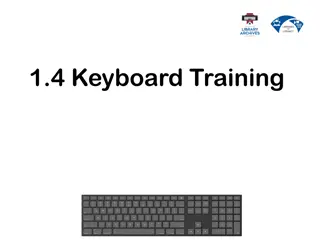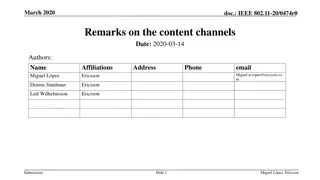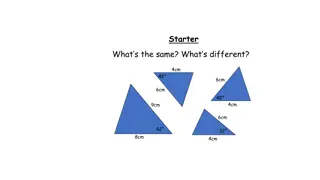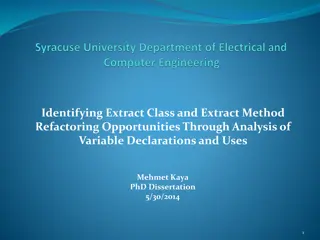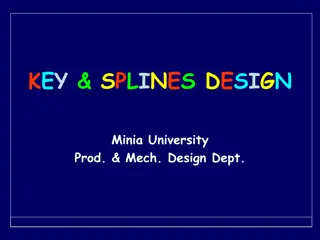Cross-VM Side Channels and Their Use to Extract Private Keys
This study delves into the exploitation of cross-VM side channels to extract private keys in virtualized environments. The research uncovers innovative methods used by attackers to breach security isolation and compromise cryptographic keys through cache-timing channels. The work explores related publications and outlines stages of cross-VM side channel probing, shedding light on the vulnerabilities in virtualized systems.
Download Presentation

Please find below an Image/Link to download the presentation.
The content on the website is provided AS IS for your information and personal use only. It may not be sold, licensed, or shared on other websites without obtaining consent from the author.If you encounter any issues during the download, it is possible that the publisher has removed the file from their server.
You are allowed to download the files provided on this website for personal or commercial use, subject to the condition that they are used lawfully. All files are the property of their respective owners.
The content on the website is provided AS IS for your information and personal use only. It may not be sold, licensed, or shared on other websites without obtaining consent from the author.
E N D
Presentation Transcript
Cross-VM Side Channels and Their Use to Extract Private Keys Yinqian Zhang (UNC-Chapel Hill) Ari Juels (RSA Labs) Michael K. Reiter (UNC-Chapel Hill) Thomas Ristenpart (U Wisconsin-Madison)
Security Isolation by Virtualization VM VM Crypto Keys Attacker Victim Virtualization Layer Computer Hardware
Access-Driven Cache Timing Channel VM VM Crypto Keys Attacker Victim Side Channels Virtualization (Xen) An open problem: Are cryptographic side channel attacks possible in virtualization environment?
Related Work Multi- Core w/o SMT Publication Virtualization Target Percival 2005 RSA Osvik et al. 2006 Neve et al. 2006 AES AES Aciicmez 2007 RSA Aciicmez et al. 2010 DSA Bangerter 2011 AES
Related Work Multi- Core w/o SMT Publication Virtualization Target Percival 2005 RSA Osvik et al. 2006 Neve et al. 2006 AES AES Aciicmez 2007 RSA Ristenpart el al. 2009 load Aciicmez et al. 2010 DSA Bangerter 2011 AES
Related Work Multi- Core w/o SMT Publication Virtualization Target Percival 2005 RSA Osvik et al. 2006 Neve et al. 2006 AES AES Aciicmez 2007 RSA Ristenpart el al. 2009 load Aciicmez et al. 2010 DSA Bangerter 2011 Our work AES ElGamal
Outline Stage 1 Stage 2 Cross-VM Side Channel Probing Cache Pattern Classification Vectors of cache measurements Sequences of SVM- classified labels Noise Reduction Code-Path Reassembly Fragments of code path Stage 3 Stage 4
Digress: Prime-Probe Protocol PRIME PRIME-PROBE Interval PROBE Time 4-way set associative L1 I-Cache Cache Set
Cross-VM Side Channel Probing VM VM Victim Attacker Virtualization (Xen) L1 L1 L1 L1 I-Cache I-Cache I-Cache I-Cache
Challenge: Observation Granularity VM/VCPU VM/VCPU W/ SMT: tiny prime- probe intervals W/o SMT: gaming schedulers Attacker Victim L1 I-Cache Time 30ms 30ms
Ideally Time Short intervals Use Interrupts to preempt the victim: Timer interrupts? Network interrupts? HPET interrupts? Inter-Processor interrupts (IPI)!
Inter-Processor Interrupts Attacker VM For( ; ; ) { send_IPI(); Delay(); } VM/VCPU Attacker VCPU IPI Victim VCPU Virtualization (Xen) CPU core CPU core
Cross-VM Side Channel Probing Time 2.5 s 2.5 s 2.5 s
Outline Stage 1 Stage 2 Cross-VM Side Channel Probing Cache Pattern Classification Vectors of cache measurements Sequences of SVM- classified labels Noise Reduction Code-Path Reassembly Fragments of code path Stage 3 Stage 4
Square-and-Multiply (libgcrypt) /* y = xe mod N , from libgcrypt*/ Modular Exponentiation (x, e, N): let en e1 be the bits of e y 1 for ei in {en e1} y Square(y) (S) y Reduce(y, N) (R) if ei = 1 then y Multi(y, x) (M) y Reduce(y, N) (R) ei = 1 SRMR ei = 0 SR
Cache Pattern Classification Key observation: Footprints of different functions are distinct in the I-Cache ! Square(): cache set 1, 3, , 59 Multi(): cache set 2, 5, , 60, 61 Reduce(): cache set 2, 3, 4, , 58 Square() Multi() Classification Reduce()
Support Vector Machine Noise: hypervisor context switch Square() Multi() SVM Reduce() Read more on SVM training
Outline Stage 1 Stage 2 Cross-VM Side Channel Probing Cache Pattern Classification Vectors of cache measurements Sequences of SVM- classified labels Noise Reduction Code-Path Reassembly Fragments of code path Stage 3 Stage 4
Noise Reduction requires robust automated error correction
Hidden Markov Model S R M Square Reduce Multi Unkn
Hidden Markov Model S R M Square Reduce Multi Unkn
Hidden Markov Model low confidence
Eliminate Non-Crypto Computation S R M Square Reduce Multi Unkn
Eliminate Non-Crypto Computation Key Observations S:M Ratio should be roughly 2:1 for long enough sequences! MM signals an error (never two sequential multiply operations)
Key Extraction Start Decryption Unkn Unkn Unkn VCPU VCPU Square Square Reduce Reduce Multi Reduce Attacker Victim Virtualization (Xen) L1 L1 L1 L1 I-Cache I-Cache I-Cache I-Cache
Multi-Core Processors 0100011... Dom0 VCPU Another VCPU Victim VCPU Attacker VCPU IPI VCPU L1 L1 L1 L1 I-Cache I-Cache I-Cache I-Cache
Multi-Core Processors ..#####... Dom0 VCPU Another VCPU Victim VCPU Attacker VCPU IPI VCPU L1 L1 L1 L1 I-Cache I-Cache I-Cache I-Cache
Multi-Core Processors ##10100... Dom0 VCPU Another VCPU Victim VCPU Attacker VCPU IPI VCPU L1 L1 L1 L1 I-Cache I-Cache I-Cache I-Cache
From an Attackers Perspective #####1001111010#### #0111101011######## ####110101101#####0 1101110############ ###########........
Outline Stage 1 Stage 2 Cross-VM Side Channel Probing Cache Pattern Classification Vectors of cache measurements Sequences of SVM- classified labels Noise Reduction Code-Path Reassembly Fragments of code path Stage 3 Stage 4
Code-Path Reassembly 1001110010 0111101111 110101101 11101110 DNA ASSEMBLY No error bit! 100111*01*1101110
Outline Stage 1 Stage 2 Cross-VM Side Channel Probing Cache Pattern Classification Vectors of cache measurements Sequences of SVM- classified labels Noise Reduction Code-Path Reassembly Fragments of code path Stage 3 Stage 4
Evaluation Intel Yorkfield processor 4 cores, 32KB L1 instruction cache Xen + linux + GnuPG + libgcrypt Xen 4.0 Ubuntu 10.04, kernel version 2.6.32.16 Victim runs GnuPG v.2.0.19 (latest) libgcrypt 1.5.0 (latest) ElGamal, 4096 bits
Results Work-Conserving Scheduler 300,000,000 prime-probe results (6 hours) Over 300 key fragments Brute force the key in ~9800 guesses Non-Work-Conserving Scheduler 1,900,000,000 prime-probe results (45 hours) Over 300 key fragments Brute force the key in ~6600 guesses
Conclusion A combination of techniques IPI + SVM + HMM + Sequence Assembly Demonstrate a cross-VM access-driven cache- based side-channel attack Multi-core processors without SMT Sufficient fidelity to exfiltrate cryptographic keys
Thank You Questions? Please contact: yinqian@cs.unc.edu
